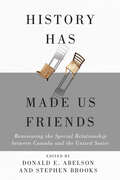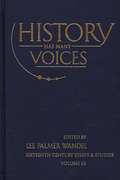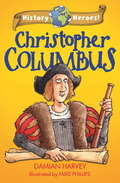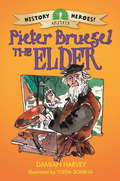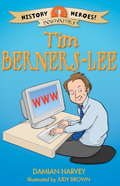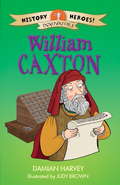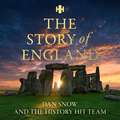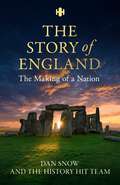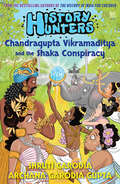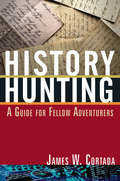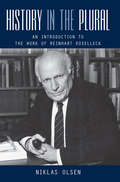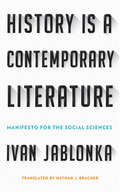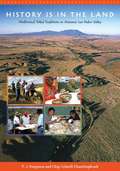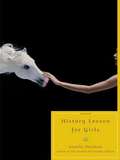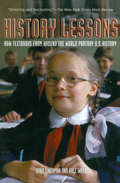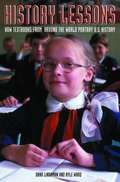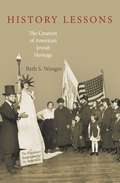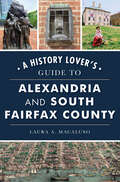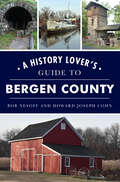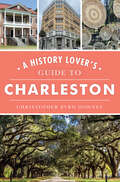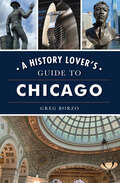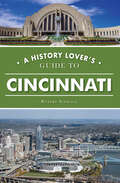- Table View
- List View
History Happened Here: The American Revolution in New York State
by New York Historical SocietyA book with a lot of illustrations exploring American Revolution.
History Has Made Us Friends: Reassessing the Special Relationship between Canada and the United States
by Donald E. Abelson and Stephen BrooksSeparated by the world’s longest land border and engaging in over three billion dollars in trade daily, Canada and the United States share security concerns, cultural interests, and a history spanning more than 250 years. Alan Rock, former Canadian ambassador to the United States, has said that this special relationship represents “a bond that is beyond practical. It borders on mystical.” The rise of nativist sentiment, however, has raised concerns over preserving this relationship.History Has Made Us Friends illuminates the nature and dynamics of Canada-US relations, examining their history, attributed meaning, and conceptualization. Contributors consider many angles and perspectives, including the impact of geopolitical change, to determine whether the relationship warrants the moniker “special.” They explore whether shared values and demographic similarities continue to cement the relationship, and if it still matters whether presidents and prime ministers get along.While things look different today from when President Kennedy declared, “What unites us is far greater than what divides us,” History Has Made Us Friends argues that the Canada-US relationship – often narrowly understood or dismissed as a relic of the past – continues to be unique and resilient.
History Has Many Voices (Sixteenth Century Essays & Studies #63)
by Lee Palmer WandelThis volume presents essays from eight scholars who trained with Robert Kingdon, a vanguard of early modern studies. He required students to go to primary sources, yet they were free to pursue their own curiosity. No matter what their approach to the sources, students were held to a high standard of thoroughness, precision, and attention to detail. This festschrift displays something of the diversity of language, source materials, methods, and visions that Kingdon encouraged in his students during his forty-year career in graduate education.
History Has Many Voices (Sixteenth Century Essays & Studies #63)
by Lee Palmer WandelThis volume presents essays from eight scholars who trained with Robert Kingdon, a vanguard of early modern studies. He required students to go to primary sources, yet they were free to pursue their own curiosity. No matter what their approach to the sources, students were held to a high standard of thoroughness, precision, and attention to detail. This festschrift displays something of the diversity of language, source materials, methods, and visions that Kingdon encouraged in his students during his forty-year career in graduate education.
History Heroes: Christopher Columbus
by Damian HarveyChristopher Columbus sailed the seas in search of the perfect trade route - find out how his life and explorations helped to change the world! Discover the stories of people who have helped to shape history, ranging from early explorers such as Christopher Columbus to more modern figures like Tim Berners-Lee, inventor of the World Wide Web. These chapter books combine historical fact with engaging narrative and humourous illustration, perfect for the newly independent reader.
History Heroes: Pieter Bruegel the Elder
by Damian Harvey Yulyia SominaPieter Bruegel, the greatest Flemmish painter of the 16th Century, developed a unique style of painting and created many masterpieces, often painting scenes of daily life. Discover the stories of people who have helped to shape history, ranging from early explorers such as Christopher Columbus to more modern figures like Tim Berners-Lee, inventor of the World Wide Web. These chapter books combine historical fact with engaging narrative and humourous illustration, perfect for the newly independent reader.
History Heroes: Tim Berners-Lee
by Damian Harvey Judy BrownTim Berners Lee started off his career building computers out of old televisions. He is now one of the most prolific internet experts in the world and was responsible for founding the World Wide Web! Discover the stories of people who have helped to shape history, ranging from early explorers such as Christopher Columbus to more modern figures like Tim Berners-Lee, inventor of the World Wide Web. These chapter books combine historical fact with engaging narrative and humourous illustration, perfect for the newly independent reader.
History Heroes: William Caxton
by Damian Harvey Judy BrownWilliam Caxton led the way in bringing the printing press to the English and made books accessible to many people. Discover the stories of people who have helped to shape history, ranging from early explorers such as Christopher Columbus to more modern figures like Tim Berners-Lee, inventor of the World Wide Web. These chapter books combine historical fact with engaging narrative and humourous illustration, perfect for the newly independent reader.
History Hit Story of England: Making of a Nation
by History Hit SnowA FRESH RETELLING OF ENGLISH HISTORY BY ACCLAIMED HISTORIAN DAN SNOW AND THE HISTORY HIT TEAM: PERFECT FOR FANS OF THE REST IS HISTORY and UNRULY! Praise for History Hit:'Really enjoyable ... highly recommended' ⭐⭐⭐⭐⭐ 'Easy to pick up and hard to put down' ⭐⭐⭐⭐⭐ 'Eye wateringly funny and jaw-droppingly astonishing' ⭐⭐⭐⭐⭐ From battlefields, cathedrals and museums to castles and stately homes, from the Lancastrians and Yorkists to the Roundheads, Royalists and an abundance of kings called Edward (and Henry!), the history of our island nation unravels its rich tapestry beneath our very feet - if only you know where to look.Take, for instance, the Tower of London, which housed a royal menagerie - featuring lions, an African elephant and even a polar bear - some three hundred years before it bore witness to Anne Boleyn's final jest with her executioner. Or the Liverpool Docks, which in the 19th century handled a whopping 9% of global trade. Or, indeed, the atomic weapons base at Orford Ness, which was used to secretly test nuclear weapons during the most heated periods of the Cold War. . . You do not have to travel far for English history to spring into rich and vivid life.In their Story of England, historian Dan Snow and the History Hit team take us on a journey through thousands of years of unceasing drama. It's a tale of invaders and immigrants and visitors and what they brought here. It's a tale of how our ancestors overcame, co-operated and shaped this country to their liking, affecting our landscape, our character, our language, industries, laws, religions and settlements with each passing century. And, ultimately, it's a tale of how England came to be how it is today.
History Hit Story of England: Making of a Nation
by History Hit SnowA FRESH RETELLING OF ENGLISH HISTORY BY ACCLAIMED HISTORIAN DAN SNOW AND THE HISTORY HIT TEAM: PERFECT FOR FANS OF THE REST IS HISTORY and UNRULY! Praise for History Hit:'Really enjoyable . . . highly recommended' ⭐⭐⭐⭐⭐ 'Easy to pick up and hard to put down' ⭐⭐⭐⭐⭐ 'Eye wateringly funny and jaw-droppingly astonishing' ⭐⭐⭐⭐⭐ From battlefields, cathedrals and museums to castles and stately homes, from the Lancastrians and Yorkists to the Roundheads, Royalists and an abundance of kings called Edward (and Henry!), the history of our island nation unravels its rich tapestry beneath our very feet - if only you know where to look.Take, for instance, the Tower of London, which housed a royal menagerie - featuring lions, an African elephant and even a polar bear - some three hundred years before it bore witness to Anne Boleyn's final jest with her executioner. Or the Liverpool Docks, which in the 19th century handled a whopping 9% of global trade. Or, indeed, the atomic weapons base at Orford Ness, which was used to secretly test nuclear weapons during the most heated periods of the Cold War. . . You do not have to travel far for English history to spring into rich and vivid life.In their Story of England, historian Dan Snow and the History Hit team take us on a journey through thousands of years of unceasing drama. It's a tale of invaders and immigrants and visitors and what they brought here. It's a tale of how our ancestors overcame, co-operated and shaped this country to their liking, affecting our landscape, our character, our language, industries, laws, religions and settlements with each passing century. And, ultimately, it's a tale of how England came to be how it is today.
History Hunters 3: Chandragupta Vikramaditya and the Shaka Conspiracy
by Archana Garodia Gupta Shruti GarodiaWhom would YOU ask for help if you knew of a terrible plot against an emperor 1,600 years ago?The gutsy foursome - Zoya, Noor, Ansh and Rohan - and their enthusiastic elephant friend Elfu are having second thoughts about their blasts in the past, after their nerve-wracking run-in with the Mughals. Yet, the next opportunity offered by the mysterious billionaire, who lives next door to their Goa resort, proves irresistible. Off they go again - this time to the fabulous and flamboyant age of the Gupta king Chandragupta Vikramaditya. A horse-mad teenage princess, an absent-minded mathematician and a face-painting spree are all very well, but what about the super-precious thing in their keeping that no one must know about? And the dark and dangerous secret that they know about the Shakas? The four friends have to save others - and themselves too! Do they have what it takes? Join the feisty and funny History Hunters as they brave the eye-popping era of the Guptas in yet another incredible adventure. PLUS! 18- PAGE FACT TRACKERMust-know information about the Gupta period!
History Hunting: A Guide for Fellow Adventurers
by James W. CortadaThe book offers guidance to aspiring historians at every stage and in every walk of life, from practical advice on tackling and organizing projects to recommendations for finding and using resources of all kinds, whether at the local library or historical society or on the world wide web. It is intended to be a serious guide to the best practices for researchers as well as a good read as a collection of research stories. The author includes useful bibliographies, vetted websites, and practical advice on doing research well.
History In The Plural
by Niklas OlsenReinhart Koselleck (1923-2006) was one of most imposing and influential European intellectual historians in the twentieth century. Constantly probing and transgressing the boundaries of mainstream historical writing, he created numerous highly innovative approaches, absorbing influences from other academic disciplines as represented in the work of philosophers and political thinkers like Hans Georg Gadamer and Carl Schmitt and that of internationally renowned scholars such as Hayden White, Michel Foucault, and Quentin Skinner. An advocate of "grand theory," Koselleck was an inspiration to many scholars and helped move the discipline into new directions (such as conceptual history, theories of historical times and memory) and across disciplinary and national boundaries. He thus achieved a degree of international fame that was unusual for a German historian after 1945. This book not only presents the life and work of a "great thinker" and European intellectual, it also contributes to our understanding of complex theoretical and methodological issues in the cultural sciences and to our knowledge of the history of political, historical, and cultural thought in Germany from the 1950s to the present.
History Is a Contemporary Literature: Manifesto for the Social Sciences
by Ivan JablonkaIvan Jablonka’s History Is a Contemporary Literature offers highly innovative perspectives on the writing of history, the relationship between literature and the social sciences, and the way that both social-scientific inquiry and literary explorations contribute to our understanding of the world. Jablonka argues that the act and art of writing, far from being an afterthought in the social sciences, should play a vital role in the production of knowledge in all stages of the researcher’s work and embody or even constitute the understanding obtained. History (along with sociology and anthropology) can, he contends, achieve both greater rigor and wider audiences by creating a literary experience through a broad spectrum of narrative modes.Challenging scholars to adopt investigative, testimonial, and other experimental writing techniques as a way of creating and sharing knowledge, Jablonka envisions a social science literature that will inspire readers to become actively engaged in understanding their own pasts and to relate their histories to the present day. Lamenting the specialization that has isolated the academy from the rest of society, History Is a Contemporary Literature aims to bring imagination and audacity into the practice of scholarship, drawing on the techniques of literature to strengthen the methods of the social sciences.
History Is in the Land: Multivocal Tribal Traditions in Arizona's San Pedro Valley
by Chip Colwell-Chanthaphonh Robert W. Preucel T. J. FergusonArizona's San Pedro Valley is a natural corridor through which generations of native peoples have traveled for more than 12,000 years, and today many tribes consider it to be part of their ancestral homeland. This book explores the multiple cultural meanings, historical interpretations, and cosmological values of this extraordinary region by combining archaeological and historical sources with the ethnographic perspectives of four contemporary tribes: Tohono O'odham, Hopi, Zuni, and San Carlos Apache. Previous research in the San Pedro Valley has focused on scientific archaeology and documentary history, with a conspicuous absence of indigenous voices, yet Native Americans maintain oral traditions that provide an anthropological context for interpreting the history and archaeology of the valley. The San Pedro Ethnohistory Project was designed to redress this situation by visiting archaeological sites, studying museum collections, and interviewing tribal members to collect traditional histories. The information it gathered is arrayed in this book along with archaeological and documentary data to interpret the histories of Native American occupation of the San Pedro Valley. This work provides an example of the kind of interdisciplinary and politically conscious work made possible when Native Americans and archaeologists collaborate to study the past. As a methodological case study, it clearly articulates how scholars can work with Native American stakeholders to move beyond confrontations over who "owns" the past, yielding a more nuanced, multilayered, and relevant archaeology.
History Lesson for Girls
by Aurelie SheehanA beautiful and resonant novel about a friendship that shaped a life during a decade of instability Everyone remembers age thirteen. For Alison Glass, it was 1975, the year she moved to Weston, Connecticut, with her bohemian parents and her horse, Jazz. Life was about trying to navigate the hypocrisies of an unfamiliar affluent town and figuring out how she might blend in at school- despite her status as the new girl with a back brace for scoliosis. Kate Hamilton, the popular daughter of an egomaniacal New Age guru-the "sham shaman"-and his substance-loving wife, was an unlikely friend, the strong girl Alison regarded as her saving grace. Bonding over their love of horses, they rode away the afternoons, creating a private world for themselves as a way to survive the excesses of their surroundings and the adults who cast them adrift in such a tumultuous time. With the clarity of hindsight, Alison looks back on how the tumult inevitably broke through. Set against the backdrop of the often hilariously tacky and disturbingly reckless 1970s, Aurelie Sheehan's luminous History Lesson for Girls is at once an emotional inquest and an elegy for a friendship that meant everything. As Alison traces the giddy highs and crushing lows that made her the person she was at thirteen, a picture emerges of a friendship that simply couldn't survive the weight of the shadows under which it was forged. Combining the poignancy and elegance of The Virgin Suicides with the sharp observational eye of The Ice Storm, History Lesson for Girls is an enchanting tribute to the lingering influence of friendship and significance of personal history.
History Lesson for Girls
by Aurelie SheehanIn her follow-up to the critically acclaimed novel The Anxiety of Everyday Objects, Aurelie Sheehan presents a moving coming-of-age story set in the disturbingly reckless and often hilariously tacky 1970s. In 1975, Alison Glass, age thirteen, moves to Connecticut with her bohemian parents and her horse, Jazz. Shy, observant, and in a back brace for scoliosis, Alison finds strength in an unlikely friendship with Kate Hamilton, the charismatic but troubled daughter of an egomaniacal New Age guru and his substance-loving wife. Seeking refuge from the chaos in their lives, the girls escape into the world of their horses. Rich in humor and heartbreak, History Lesson for Girls is an elegy to a friendship that meant everything.
History Lessons: How Textbooks from Around the World Portray U.S. History
by Dana Lindaman Kyle WardA &“fascinating&” look at what students in Russia, France, Iran, and other nations are taught about America (The New York Times Book Review). This &“timely and important&” book (History News Network) gives us a glimpse into classrooms across the globe, where opinions about the United States are first formed. History Lessons includes selections from textbooks and teaching materials used in Russia, France, Iran, Saudi Arabia, Cuba, Canada, and others, covering such events as the American Revolution, the Cuban Missile Crisis, the Iran hostage crisis, and the Korean War—providing some alternative viewpoints on the history of the United States from the time of the Viking explorers to the post-Cold War era. By juxtaposing starkly contrasting versions of the historical events we take for granted, History Lessons affords us a sometimes hilarious, often sobering look at what the world thinks about America&’s past. &“A brilliant idea.&” —Foreign Affairs
History Lessons: How Textbooks from around the World Portray U.S. History
by Dana Lindaman Kyle WardFrom the book: Instead of avoiding these difficult issues, [students' abilities to discuss and debate historical events] this work embraces them, with the intention of bringing back to the study of history those very things that make it so interesting and important. Instead of just reading about specific events, our readers have the opportunity to develop their own historical perspective and discover how individual biases, perspectives, and interpretations from around the world have shaped our understanding of specific historical events. Library Journal Textbooks are political documents, commissioned methods for molding students' viewpoints as well as instruments for conveying essential facts. By compiling excerpts of secondary-school manuals from largely Anglophone although not exclusively European sources, Ward (history, Vincennes Univ.) and Lindaman (a doctoral candidate at Harvard) provide a valuable service for those largely familiar with U.S. texts only. The use of post-Soviet Russian sources as well as Cuban and North Korean works is especially revealing. After an introduction delineating national differences among foreign publishers and the caveat that "most languages have passive constructions that allow them to speak of something without assigning blame," the authors submit selected historical passages ranging chronologically from the European discovery of the "New World" to the post-Cold War era. The book clearly shows that the United States developed within a global context and that U.S. history was especially intricately intertwined with that of its hemispheric neighbors. That said, there are few new insights for most well-read historians. All the texts assessed are from 1988 through 2001, which necessarily sets this work in time; it would be enlightening to see a similar study done ten years hence. Recommended for public libraries and teachers' college collections.-Frederick J. Augustyn Jr., Library of Congress Copyright 2004 Reed Business Information.
History Lessons: The Creation of American Jewish Heritage
by Beth S. WengerMost American Jews today will probably tell you that Judaism is inherently democratic and that Jewish and American cultures share the same core beliefs and values. But in fact, Jewish tradition and American culture did not converge seamlessly. Rather, it was American Jews themselves who consciously created this idea of an American Jewish heritage and cemented it in the popular imagination during the late nineteenth and mid-twentieth centuries. History Lessons is the first book to examine how Jews in the United States collectively wove themselves into the narratives of the nation, and came to view the American Jewish experience as a unique chapter in Jewish history.Beth Wenger shows how American Jews celebrated civic holidays like Thanksgiving and the Fourth of July in synagogues and Jewish community organizations, and how they sought to commemorate Jewish cultural contributions and patriotism, often tracing their roots to the nation's founding. She looks at Jewish children's literature used to teach lessons about American Jewish heritage and values, which portrayed--and sometimes embellished--the accomplishments of heroic figures in American Jewish history. Wenger also traces how Jews often disagreed about how properly to represent these figures, focusing on the struggle over the legacy of the Jewish Revolutionary hero Haym Salomon.History Lessons demonstrates how American Jews fashioned a collective heritage that fused their Jewish past with their American present and future.
History Lover's Guide to Alexandria and South Fairfax County, A (History & Guide)
by Laura A. MacalusoHistory is nurtured and treasured in the City of Alexandria and in neighboring South Fairfax County. A History Lover's Guide to Alexandria & South Fairfax County focuses on this special area along the Potomac River.Travel through history from Old Town to Mason's Neck and witness the practice of preservation as it continues to evolve today. Alexandria cares for the places essential to understanding our shared past, from cobblestone streets to the always active waterfront. Visit the numerous museums and historic houses, many of which are iconic in American history, in Old Town. Learn the stories of Alexandria's African American community, from slavery to freedom. Discover neighborhoods like Del Ray and Seminary Hill. South of the city, travel the George Washington Memorial Parkway and walk in the footsteps of Washington himself. Historian and preservationist Laura Macaluso draws connections between city and county, and between past and present.
History Lover's Guide to Bergen County, A (Landmarks)
by Bob Nesoff Howard Joseph CohnFrom the crossroads of the American Revolution to the construction of the George Washington Bridge, New Jersey's Bergen County has a history that has shaped not only the metropolitan area, but the nation itself. Featuring narratives of key historical moments, legendary personalities and fascinating landmarks, this guide to Bergen County's past is essential for any resident or visitor alike. Take a copy along as you traverse the county and discover the historic sites within and the stories behind them. Authors Bob Nesoff and Howard Joseph Cohn take readers on a fascinating journey through Bergen County's incredible past.
History Lover's Guide to Charleston, A (History & Guide)
by Christopher Byrd DowneyFounded in 1670, Charleston is among the oldest cities in the nation and site of some of the most pivotal events in American history. Explore the city and discover the Old Exchange and Provost Dungeon where South Carolina ratified the U.S. Constitution in 1788. Visit beautiful Rainbow Row and learn the true history of this most iconic of Charleston sites. Tour the city's oldest church edifice at St. Michael's Church, which first opened for services in 1761. Join historian and author Christopher Byrd Downey for a guided tour of nearly one hundred historic Charleston sites tailor-made for the history lover.
History Lover's Guide to Chicago, A (History & Guide)
by Greg BorzoFounded next to a great lake and a sluggish river, Chicago grew faster than any city ever has. Splendid department stores created modern retailing, and the skyscraper was invented to handle the needs of booming businesses in an increasingly concentrated downtown. The stockyards fed the world, and railroads turned the city into the nation's transportation hub. A great fire leveled the city, but Chicago rose again. Glorious museums, churches and theaters sprang up. Explore a missile site that became a bird sanctuary and discover how Chicago's first public library came to be located in an abandoned water tank. Follow the steps of business leaders and society dames, anarchists and army generals, and learn whose ashes were surreptitiously sprinkled over Wrigley Field. Combining years of research and countless miles of guided tours, author Greg Borzo pursues Chicago's sweeping historical arc through its fascinating nooks and crannies.
History Lover's Guide to Cincinnati, A (History & Guide)
by Robert SchrageA tour of the Queen City's rich heritage One of the oldest cities in the Midwest, Cincinnati has history in its bones. In the 1800s, the city was often styled the "Paris of America" due in part to ambitious architectural projects like the Music Hall, Cincinnatian Hotel, and city hall. Many of these historical structures still exist. The city also has sundry links to American presidents, whose stories can still be seen if you know where to look. Thriving destinations like Over the Rhine and Findlay Market provide glimpses of Cincinnati as it once was and how it is today. Offering something for native and visitor alike, author Robert Schrage leads a trip through the past and present of one of the nation's most historic cities.

